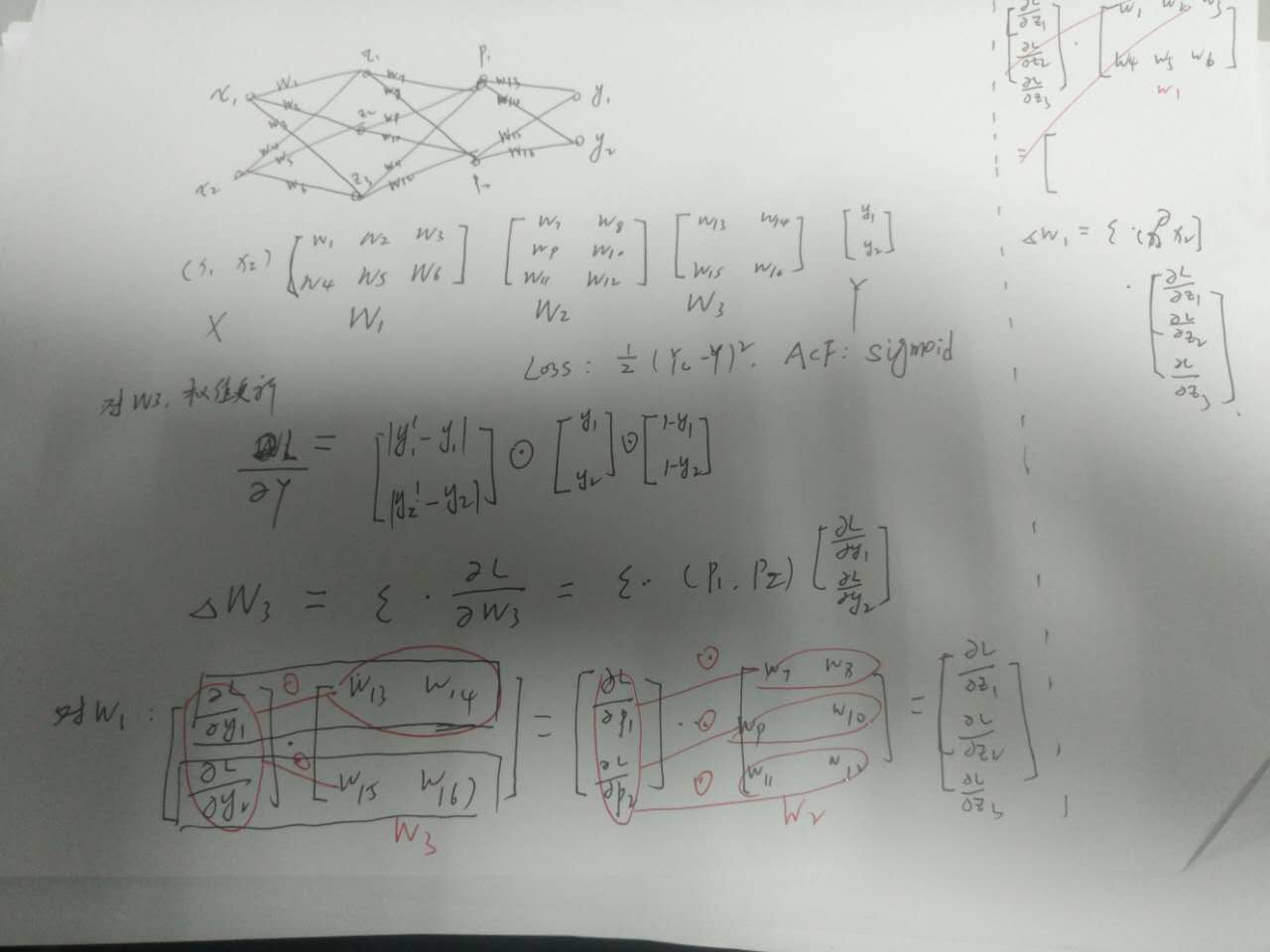神經網絡的相關知識(1.python 實現MLp)
阿新 • • 發佈:2017-08-30
技術分享 num pre func sin date 傳播 prop etime
轉載於:http://blog.csdn.net/miangangzhen/article/details/51281989
#!usr/bin/env python3 # -*- coding:utf-8 -*- import numpy as np import math # definition of sigmoid funtion # numpy.exp work for arrays. def sigmoid(x): return 1 / (1 + np.exp(-x)) # definition of sigmoid derivative funtion# input must be sigmoid function‘s result def sigmoid_output_to_derivative(result): return result*(1-result) # init training set def getTrainingSet(nameOfSet): setDict = { "sin": getSinSet(), } return setDict[nameOfSet] def getSinSet(): x= 6.2 * np.random.rand(1) - 3.14 x = x.reshape(1,1) # y = np.array([5 *x]).reshape(1,1) # y = np.array([math.sin(x)]).reshape(1,1) y = np.array([math.sin(x),1]).reshape(1,2) return x, y def getW(synapse, delta): resultList = [] # 遍歷隱藏層每個隱藏單元對每個輸出的權值,比如8個隱藏單元,每個隱藏單元對兩個輸出各有2個權值for i in range(synapse.shape[0]): resultList.append( (synapse[i,:] * delta).sum() ) resultArr = np.array(resultList).reshape(1, synapse.shape[0]) return resultArr def getT(delta, layer): result = np.dot(layer.T, delta) return result def backPropagation(trainingExamples, etah, input_dim, output_dim, hidden_dim, hidden_num): # 可行條件 if hidden_num < 1: print("隱藏層數不得小於1") return # 初始化網絡權重矩陣,這個是核心 synapseList = [] # 輸入層與隱含層1 synapseList.append(2*np.random.random((input_dim,hidden_dim)) - 1) # 隱含層1與隱含層2, 2->3,,,,,,n-1->n for i in range(hidden_num-1): synapseList.append(2*np.random.random((hidden_dim,hidden_dim)) - 1) # 隱含層n與輸出層 synapseList.append(2*np.random.random((hidden_dim,output_dim)) - 1) iCount = 0 lastErrorMax = 99999 # while True: for i in range(10000): errorMax = 0 for x, y in trainingExamples: iCount += 1 layerList = [] # 正向傳播 layerList.append( sigmoid(np.dot(x,synapseList[0])) ) for j in range(hidden_num): layerList.append( sigmoid(np.dot(layerList[-1],synapseList[j+1])) ) # 對於網絡中的每個輸出單元k,計算它的誤差項 deltaList = [] layerOutputError = y - layerList[-1] # 收斂條件 errorMax = layerOutputError.sum() if layerOutputError.sum() > errorMax else errorMax deltaK = sigmoid_output_to_derivative(layerList[-1]) * layerOutputError deltaList.append(deltaK) iLength = len(synapseList) for j in range(hidden_num): w = getW(synapseList[iLength - 1 - j], deltaList[j]) delta = sigmoid_output_to_derivative(layerList[iLength - 2 - j]) * w deltaList.append(delta) # 更新每個網絡權值w(ji) for j in range(len(synapseList)-1, 0, -1): t = getT(deltaList[iLength - 1 -j], layerList[j-1]) synapseList[j] = synapseList[j] + etah * t t = getT(deltaList[-1], x) synapseList[0] = synapseList[0] + etah * t print("最大輸出誤差:") print(errorMax) if abs(lastErrorMax - errorMax) < 0.0001: print("收斂了") print("####################") break lastErrorMax = errorMax # 測試訓練好的網絡 for i in range(5): xTest, yReal = getSinSet() layerTmp = sigmoid(np.dot(xTest,synapseList[0])) for j in range(1, len(synapseList), 1): layerTmp = sigmoid(np.dot(layerTmp,synapseList[j])) yTest = layerTmp print("x:") print(xTest) print("實際的y:") print(yReal) print("神經元網絡輸出的y:") print(yTest) print("最終輸出誤差:") print(np.abs(yReal - yTest)) print("#####################") print("叠代次數:") print(iCount) if __name__ == ‘__main__‘: import datetime tStart = datetime.datetime.now() # 使用什麽樣的訓練樣例 nameOfSet = "sin" x, y = getTrainingSet(nameOfSet) # setting of parameters # 這裏設置了學習速率。 etah = 0.01 # 隱藏層數 hidden_num = 2 # 網絡輸入層的大小 input_dim = x.shape[1] # 隱含層的大小 hidden_dim = 100 # 輸出層的大小 output_dim = y.shape[1] # 構建訓練樣例 trainingExamples = [] for i in range(10000): x, y = getTrainingSet(nameOfSet) trainingExamples.append((x, y)) # 開始用反向傳播算法訓練網絡 backPropagation(trainingExamples, etah, input_dim, output_dim, hidden_dim, hidden_num) tEnd = datetime.datetime.now() print("time cost:") print(tEnd - tStart)
分析:
1.正向傳播:
for j in range(1, len(synapseList), 1): layerTmp = sigmoid(np.dot(layerTmp,synapseList[j]))
synapseList 存放的是權值矩陣
2.反向傳播
a.計算隱藏層的輸出在輸入上的誤差
def getW(synapse, delta): resultList = [] # 遍歷隱藏層每個隱藏單元對每個輸出的權值,比如8個隱藏單元,每個隱藏單元對兩個輸出各有2個權值 for i in range(synapse.shape[0]): resultList.append( (synapse[i,:] * delta).sum() ) resultArr = np.array(resultList).reshape(1, synapse.shape[0]) return resultArr
比如:

神經網絡的相關知識(1.python 實現MLp)
